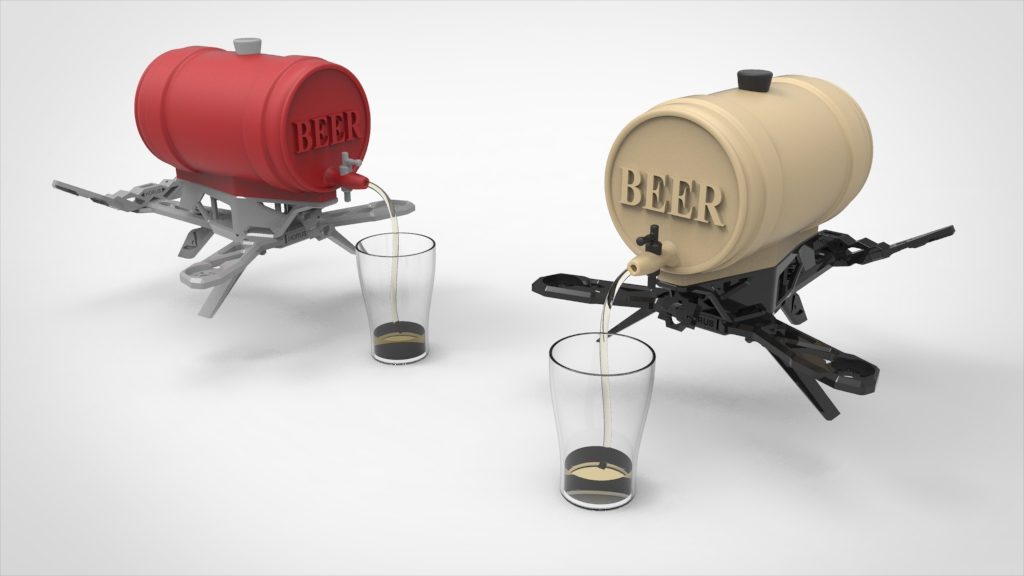People have different interpretations concerning drones. Some say they are just backyard toys for hobbyists, others believe drones are the future of delivery systems, and a good number of people view drones as military ghosts in the sky ready to strike at a moment’s notice. But whatever you think of them, it seems that the era of the drone is just begining, and drone design is a rapidly growing field.
In the aviation world, drones fall under the UAV (Unmanned Aerial Vehicle) category and they can be either autonomous or remotely piloted. Just like GPS, drones were initially developed for military purposes such as taking aerial photographs and kamikaze bombing. While many view drones as a very recent idea, early development of remotely controlled aircraft really started about a century ago during World War I. Now, though, the technology has become much more sophisticated.
Drones are no longer exclusively militaristic. These unmanned aerial vehicles are now being manufactured in many countries by a lot of different companies worldwide. Price is also relatively inexpensive for such sophisticated piece of technology; it is safe to say that someone with a modest income can afford one of the latest consumer models. For example, the Phantom 4 Professional Quadcopter manufactured by DJI (currently the biggest drone manufacturer) is available for under $2,000. Many models are actually cheaper than that too. Despite the fact that drones were originally used for military missions, the technology has a lot of potential to serve more purposes in the future, including but not limited to photography/videos, e-commerce, and Internet access.
Photography Drones
A drone is basically an RC toy on steroids. It can cover wider distance without losing connectivity and make difficult maneuvers without crashing afterward. Equipped with a high-resolution camera, a drone offers interesting perspectives from above. It does not matter if you use it for fun or serious professional photography; the camera opens the doors to various practical uses.
- Journalism: a quick Google search for “drone courses” reveals that a lot of journalism schools now offer classes where students learn to use drones as storytelling tools. Instead of using conventional cameras to capture eye-catching photos of political figures or rock shows, journalists often find that using drones is easier and more efficient. Drone and camera are controlled from a smartphone or stand-alone controller with a screen to display real-time video feed. Modern drones also cover long range transmission to thousands of feet (although there are more restrictive regulations in certain areas). Thanks to drones, journalists can sit back in the shade and still do their jobs well and produce memorable, informative images that tell a story.
- Extreme sports documentation: drones are excellent tools to capture intimate close-up shots of extreme sports athletes in actions. Extreme sports such as base jumping, skiing, snowboarding, or dessert rallies call for extreme photographers as well, but drones can cover the needs for comprehensive picture documentations pretty easily. It’s a lot easier to get that amazing aerial shot with a drone than with an enormous, expensive, and super-loud helicopter.
- Property sales/constructions: Real estate agents can use drones to capture shot after shot of the property they want to sell and post the images online with the listing. Taken from an altitude, the image delivers more comprehensive details of the building, neighborhood, roads, and everything else within close proximity of the property. The same thing applies to construction/reconstruction projects. For example a reconstruction project of a building in the aftermath of natural disasters. Drones can capture aerial photographs to show the remaining frames of the building based on which an architect can make plans on how to reconstruct the damaged parts without aggravating the damage.
E-commerce
Give it a GPS receiver, and the drone can fly to wherever you want it to fly. At least that is the basic idea of using drone as a delivery system in the retail industry. Delivery drones have been in the news for quite a while now; long enough to create big expectations among the general consumers worldwide. Currently, there are two major companies developing ambitious yet realistic plans to make delivery drones plausible.

- Amazon Prime Air: Amazon.com is probably the company most associated with the idea of using drone technology as part of its delivery system. As vague as it may seemed at first, the company actually launched a successful trial of Amazon Prime Air service last December in Cambridge, U.K. The drone carried a package containing popcorn and Fire TV device. It flew from rural corner of England to a farmhouse in Cambridge. The destination was only about several miles away from Amazon local center, and the drone covered that distance in 13 minutes. It was short, but Amazon has proven that drone delivery is far from impossible. It is worth mentioning that the trial was permitted only in daylight hours with good visibility and weather conditions.
- Project Wing: besides Amazon, there is another big name company trying to shake up the delivery business: Project Wing by Google. In fact, Google preceded Amazon in terms of a successful real-world trial. Alphabet, Google’s parent company, has plans to deploy considerable scale of drone delivery system in 2017 as part of Project Wing. Google X is the division responsible for the development of the project. According to Business Insider, the division has been testing its drones in Queensland, Australia and successfully made a delivery to farmers in 2014.
- Local businesses: small local businesses that use drones for delivery may sound farfetched now, but with the rapid developments in technology and the ever-decreasing prices, it may be closer than you think. If you think of smartphones, it wasn’t long ago that they seemed superfluous and costly. Autonomous GPS-guided drones are expensive today, but the price will be substantially less in 5 – 10 years. Who knows! In a few years you might be getting your hotdogs delivered by drones.
Internet Access
Photography and delivery drones are in their early developments, yet it appears certain that they will eventually prevail, especially considering the big companies backing them with seemingly endless financial resources. Apart from the aforementioned future uses of drones, there is another area worth noting that has only recently begun to really get people’s attention: wireless internet access. Once again, only big companies are willing to undertake ambitious projects to deliver Internet access via drones.
- Project SkyBender: since early 2016, Google has been testing a method of delivering high-speed Internet from the air using solar-powered drones. Developed as a project codenamed SkyBender, Google has been trying to find a new way to provide high-speed Internet through millimeter wave technology. The goal is to reach Internet speed 40 times faster than the current 4G connection. According to The Guardian, Project SkyBender is part of Google Aces team, which also works on Project Loon, a plan to deliver wireless Internet access via unpowered balloons floating in the stratosphere.
- Facebook: Mark Zuckerberg’s internet.org also has the same plan to use drones for wireless internet access. Its solar-powered drone has the same wingspan as Boeing 737 jetliner and is designed to circle around the earth in the stratosphere, too.
Similar to merchandise delivery system mentioned above, internet access via drones is still in early stage of development. While the two pioneers, Google and Facebook, have managed to achieve what they intended to do in trial, there are still many technical hurdles to overcome in real world usage. Regardless of the difficulties, however, they have proven that such systems are viable. When more communication companies adapt the technology, the entire system we use to transmit and receive data could be made substantially more efficient That means cheaper operational cost and more accessible internet for users.
Aerial vehicles are an impressive piece of technology from an engineering standpoint, and now we are living in a world where unmanned aerial vehicles are all around us. Drones are versatile vehicles that can be mounted with navigational systems, cargo, weapons, cameras, internet signals transmitter, and basically any other device depending on what you need. Who knows what other creative uses of drones we might see!
Worldwide adoption for drones is growing. Some use drones for fun, while others utilize the technology for commercial, technological, or even military purposes. In the coming years, you can expect that there will be more drones for more purposes hovering above more areas in more countries.
Are you developing the next big idea in drone design? Cad Crowd is here to help! With the world’s best freelance engineers, designers, and contract manufacturers at your fingertips, Cad Crowd is a one-stop-shop for all your product design and development needs! Get a free quote today!

